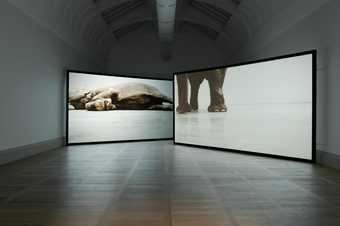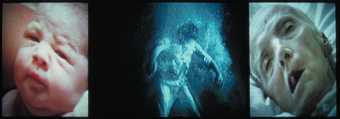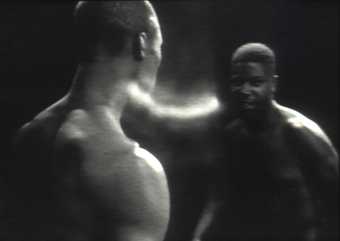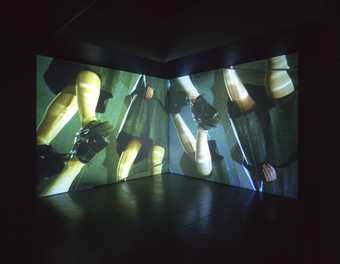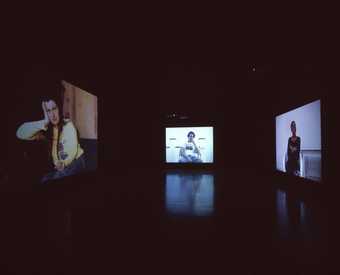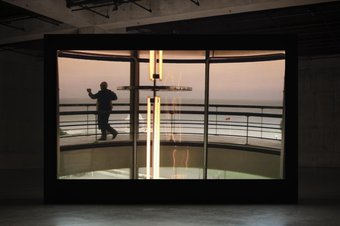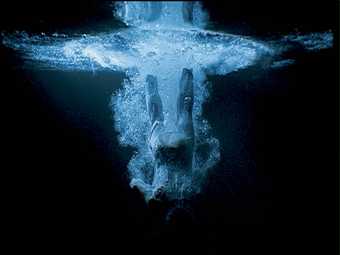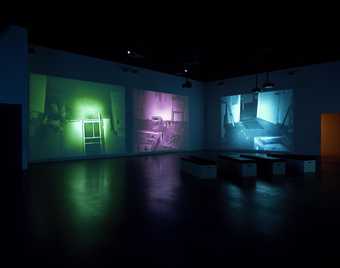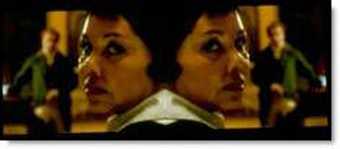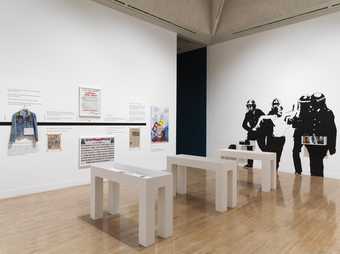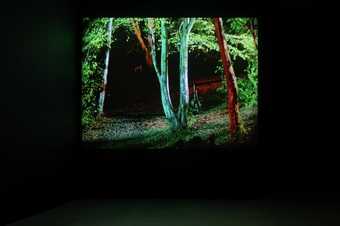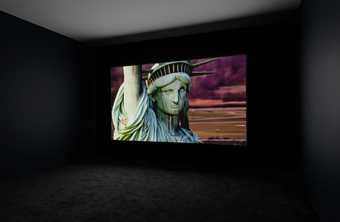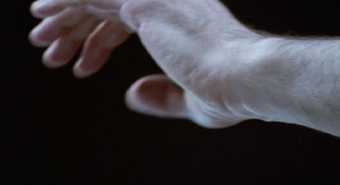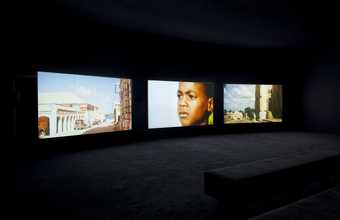Not on display
- Artist
- Sir Steve McQueen born 1969
- Medium
- Video, 3 projections, colour and sound
- Dimensions
- Duration: 28min, 53sec
duration: 24min, 12sec
duration: 12min, 6sec - Collection
- Tate
- Acquisition
- Purchased 2005
- Reference
- T12019
Summary
Caribs’ Leap / Western Deep comprises two complementary films that are shown together as a three-screen, synchronised colour video projection. The films were originally commissioned for the Documenta 11 exhibition in Kassel, Germany in 2002. They were then screened in London by Artangel in the former Lumiere Cinema on St Martins Lane in the autumn of that same year.
The film Caribs’ Leap is projected onto two of the three screens, which face each other. It was filmed on the Caribbean island of Grenada, where the artist’s parents were born, and memorialises a historical incident that took place there in 1651, over 150 years after the explorer Christopher Columbus first arrived at the island. For all this time the local Carib Indians fiercely resisted European colonisation, resulting in a temporary truce with the French in 1650 before fighting erupted again and the French triumphed. The last Caribs chose to jump to their deaths rather than submit to the Europeans, an event that is said to have occurred at a cliff in the town of Sauteurs, now known as Caribs’ Leap. McQueen’s film was shot at the site of this extraordinary act of collective resistance and sacrifice. The larger of the two screens shows the sky and its reflection in the shallow waters of the sea. Periodically the calm of the scene is disrupted by a figure falling vertiginously through the air. The figure is viewed mid-flight, never seen jumping or landing. The smaller screen opposite documents the passage of time in Grenada during the course of a day. The film begins in the pale light of dawn. McQueen captures life on the beachfront and the dock where boats pass by. Towards the end of the film the camera moves into a funeral parlour where the dead lie in highly polished coffins. McQueen was inspired to make Caribs’ Leap after visiting Grenada for his grandmother’s funeral; the subject matter of the film is therefore highly personal and elegiac.
Western Deep was filmed in the deepest gold mines in the world, the TauTona mines in the Witwatersrand Reef near Johannesburg in South Africa. Three and a half kilometres underground, the mines represent the deepest anyone has been into the core of the Earth. Working at such deep levels has serious and potentially dangerous consequences for the miners. The temperature can read seventy degrees Celsius. In the deepest parts of the mines the pressure above the miners is 9,500 tonnes per metre squared, or approximately 920 times normal atmospheric pressure. The film follows the miners as they descend into the mines in industrial lifts, and conveys the darkness and claustrophobia of the shafts as well as the dust and the noise in such confined spaces. One of the most striking things about the installation, however, is the sound. Art critic Thomas McEvilley has described the experience of watching the film:
Enormous jarring sounds of mechanical equipment and metallic screeching and crashing accompanied the descent into darkness, with occasional flashing lights offering glimpses of the miners as they descended ever farther, getting out of the lift at its occasional subterranean stops. The message seemed to be that labour in a capitalist society is a hell of exploitation and humiliation.
(McEvilley 2002, http://www.frieze.com/issue/article/documenta_112, accessed 17 April 2012.)
The Western Deep mines have been functioning under the same management since apartheid. In the depths of the mine the predominantly black miners are shown performing supervised exercises, stepping up and down as red buzzers blare above their heads. Some of them can barely move. The blank and staring faces of the miners and their apparent impassivity to their inhospitable working environment suggest that they are rehearsing their own deaths and interments.
The strength and stoicism of the miners indicates the capacity of people to survive in extreme environments, and in this way relates albeit paradoxically to the Caribs’ bravery and defiance in choosing self-destruction over capitulation to a conquering power. The two films are structured around descent: the controlled descent of the miners travelling two miles underground in Western Deep is a counterpoint to the free-falling figure in Caribs’ Leap. With this in mind, it is possible to see the people in Caribs’ Leap as Icarus figures or angelic messengers in contrast to the miners in the underground hell of Western Deep.
Further reading
James Lingwood (ed.), Steve McQueen: Caribs’ Leap / Western Deep, exhibition catalogue, Documenta 11, Kassel 2002.
Thomas McEvilley, ‘Documenta 11’, Frieze, no.69, September 2002, http://www.frieze.com/issue/article/documenta_112, accessed 17 April 2012.
Rachel Taylor
April 2012
Does this text contain inaccurate information or language that you feel we should improve or change? We would like to hear from you.
Explore
- architecture(30,960)
-
- industrial(2,075)
-
- mine(116)
- emotions and human qualities(5,345)
-
- courage(56)
- black(796)
- group(4,227)
- cities, towns, villages (non-UK)(13,323)
-
- Sauteurs(1)
- Caribbean(474)
- Grenada(2)
- South Africa(92)
- social comment(6,584)
-
- civil rights(183)
- colonialism(429)
- race(381)
- industrial and crafts(1,327)
-
- miner(128)
You might like
-
Douglas Gordon Play Dead; Real Time (this way, that way, the other way)
2003 -
Douglas Gordon Looking Down With His Black, Black, Ee
2008 -
Bill Viola Nantes Triptych
1992 -
Sir Steve McQueen Bear
1993 -
Jane and Louise Wilson Gamma
1999 -
Sam Taylor-Johnson OBE Killing Time
1994 -
Ian Breakwell The Other Side
2002 -
Bill Viola Five Angels for the Millennium
2001 -
Sir Isaac Julien CBE RA Vagabondia
2000 -
Jeremy Deller The Battle of Orgreave Archive (An Injury to One is an Injury to All)
2001 -
Adam Chodzko Nightvision
1998 -
Sir Steve McQueen Static
2009 -
Douglas Gordon Feature Film
1999 -
Sir John Akomfrah CBE The Unfinished Conversation
2012


